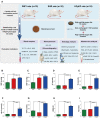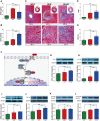A rat model of metabolic syndrome-related heart failure with preserved ejection fraction phenotype: pathological alterations and possible molecular mechanisms
- PMID: 37469482
- PMCID: PMC10352810
- DOI: 10.3389/fcvm.2023.1208370
A rat model of metabolic syndrome-related heart failure with preserved ejection fraction phenotype: pathological alterations and possible molecular mechanisms
Abstract
Background: Heart failure with preserved ejection fraction (HFpEF) represents a syndrome involving multiple pathophysiologic disorders and clinical phenotypes. This complexity makes it challenging to develop a comprehensive preclinical model, which presents an obstacle to elucidating disease mechanisms and developing new drugs. Metabolic syndrome (MetS) is a major phenotype of HFpEF. Thus, we produced a rat model of the MetS-related HFpEF phenotype and explored the molecular mechanisms underpinning the observed pathological changes.
Methods: A rat model of the MetS-related HFpEF phenotype was created by feeding spontaneously hypertensive rats a high-fat-salt-sugar diet and administering streptozotocin solution intraperitoneally. Subsequently, pathological changes in the rat heart and their possible molecular mechanisms were explored.
Results: The HFpEF rats demonstrated primary features of MetS, such as hypertension, hyperglycemia, hyperlipidemia, insulin resistance, and cardiac anomalies, such as left ventricular (LV) remodeling and diastolic impairment, and left atrial dilation. Additionally, inflammation, myocardial hypertrophy, and fibrosis were observed in LV myocardial tissue, which may be associated with diverse cellular and molecular signaling cascades. First, the inflammatory response might be related to the overexpression of inflammatory regulators (growth differentiation factor 15 (GDF-15), intercellular adhesion molecule-1 (ICAM-1), and vascular endothelial cell adhesion molecule-1 (VCAM-1)). Secondly, phosphorylated glycogen synthase kinase 3β (GSK-3β) may stimulate cardiac hypertrophy, which was regulated by activated -RAC-alpha serine/threonine-protein kinase (AKT). Finally, the transforming growth factor-β1 (TGF-β1)/Smads pathway might regulate collagen production and fibroblast activation, promoting myocardial fibrosis.
Conclusion: The HFpEF rat replicates the pathology and clinical presentation of human HFpEF with MetS and may be a reliable preclinical model that helps elucidate HFpEF pathogenesis and develop effective treatment strategies.
Keywords: AKT/GSK-3β; GDF-15; ICAM-1; TGF-β1/Smad; VCAM-1; heart failure with preserved ejection fraction; metabolic syndrome.
© 2023 Shi, Liu, Yang, Qiao, Liu, Liu and Dong.
Conflict of interest statement
The authors declare that the research was conducted in the absence of any commercial or financial relationships that could be construed as a potential conflict of interest.
Figures






Similar articles
-
Sacubitril/valsartan attenuates myocardial inflammation, hypertrophy, and fibrosis in rats with heart failure with preserved ejection fraction.Eur J Pharmacol. 2023 Dec 15;961:176170. doi: 10.1016/j.ejphar.2023.176170. Epub 2023 Nov 7. Eur J Pharmacol. 2023. PMID: 37939991
-
Ling-Gui-Qi-Hua formula alleviates left ventricular myocardial fibrosis in rats with heart failure with preserved ejection fraction by blocking the transforming growth factor-β1 /Smads signaling pathway.J Ethnopharmacol. 2023 Dec 5;317:116849. doi: 10.1016/j.jep.2023.116849. Epub 2023 Jun 28. J Ethnopharmacol. 2023. PMID: 37385575
-
Effects and mechanism of Compound Qidan Formula on rats with HFpEF induced by hypertension and diabetes mellitus based on Ang Ⅱ/TGF-β1/Smads signaling pathway.J Ethnopharmacol. 2023 Sep 15;313:116558. doi: 10.1016/j.jep.2023.116558. Epub 2023 Apr 26. J Ethnopharmacol. 2023. PMID: 37116729
-
A novel paradigm for heart failure with preserved ejection fraction: comorbidities drive myocardial dysfunction and remodeling through coronary microvascular endothelial inflammation.J Am Coll Cardiol. 2013 Jul 23;62(4):263-71. doi: 10.1016/j.jacc.2013.02.092. Epub 2013 May 15. J Am Coll Cardiol. 2013. PMID: 23684677 Review.
-
Clinical Phenotypes of Heart Failure With Preserved Ejection Fraction to Select Preclinical Animal Models.JACC Basic Transl Sci. 2022 May 25;7(8):844-857. doi: 10.1016/j.jacbts.2021.12.009. eCollection 2022 Aug. JACC Basic Transl Sci. 2022. PMID: 36061340 Free PMC article. Review.
Cited by
-
FRBM Mini REVIEW: Chemogenetic approaches to probe redox dysregulation in heart failure.Free Radic Biol Med. 2024 May 1;217:173-178. doi: 10.1016/j.freeradbiomed.2024.03.027. Epub 2024 Mar 31. Free Radic Biol Med. 2024. PMID: 38565399 Free PMC article. Review.
-
Sexual dimorphism in animal models of heart failure with preserved ejection fraction.J Appl Physiol (1985). 2025 Jun 1;138(6):1449-1473. doi: 10.1152/japplphysiol.00595.2024. Epub 2025 May 5. J Appl Physiol (1985). 2025. PMID: 40323734 Free PMC article. Review.
-
Gastric GDF15 levels are regulated by age, sex, and nutritional status in rodents and humans.J Endocrinol Invest. 2024 May;47(5):1139-1154. doi: 10.1007/s40618-023-02232-y. Epub 2023 Nov 13. J Endocrinol Invest. 2024. PMID: 37955834
-
The Visceral Adiposity Index and Its Usefulness in the Prediction of Cardiometabolic Disorders.Nutrients. 2025 Jul 20;17(14):2374. doi: 10.3390/nu17142374. Nutrients. 2025. PMID: 40732999 Free PMC article. Review.
References
LinkOut - more resources
Full Text Sources
Miscellaneous

